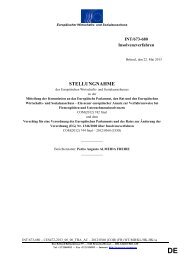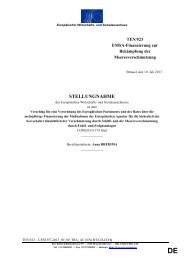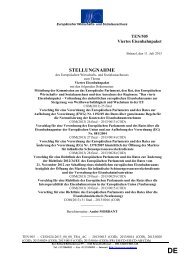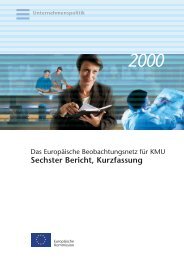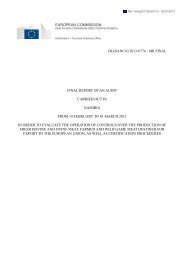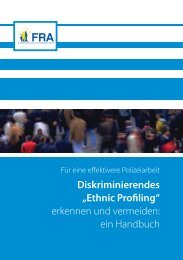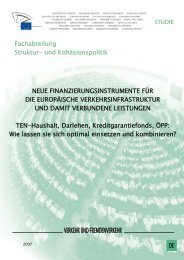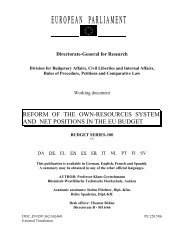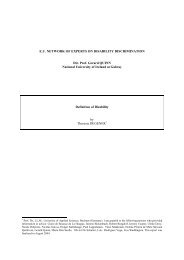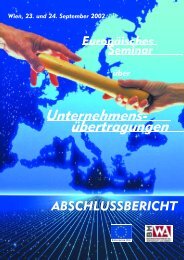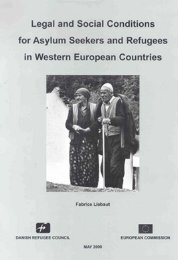Bulgaria - The social impact of seasonal migration
Bulgaria - The social impact of seasonal migration
Bulgaria - The social impact of seasonal migration
Create successful ePaper yourself
Turn your PDF publications into a flip-book with our unique Google optimized e-Paper software.
32<br />
granted by the Bureau <strong>of</strong> the UNHCR in S<strong>of</strong>ia. In 1993, 120 persons from Croatia, mainly<br />
women and children possessing legal refugee status, resided in <strong>Bulgaria</strong> and were<br />
accommodated by the Ministry <strong>of</strong> Labour and Social Welfare through an emergency<br />
fund <strong>of</strong> the state budget (Bobeva 1994, 234).<br />
In 1992-3, a National Bureau for Territorial Asylum and Refugees was established, which<br />
in 1999-2000 was transformed into an Agency for Refugees with the Council <strong>of</strong> Ministers,<br />
becoming a State Agency for Refugees with the Council <strong>of</strong> Ministers in December 2002.<br />
This institution manages, coordinates and controls the implementation <strong>of</strong> the state<br />
policy for granting a refugee and humanitarian status to foreigners in the Republic <strong>of</strong><br />
<strong>Bulgaria</strong>. It has five directorates, an inspectorate, and three territorial units, namely two<br />
registration and reception centres in S<strong>of</strong>ia and in the village <strong>of</strong> Banya, Nova Zagora<br />
municipality, as well as one integration centre in S<strong>of</strong>ia. <strong>The</strong> registration and reception<br />
centres are responsible for conducting registration, accommodation, medical checks,<br />
<strong>social</strong> and medical assistance, and the procedures for granting refugee and<br />
humanitarian status until the respective decision on the application for asylum enters<br />
into force. <strong>The</strong> integration centre provides vocational training, courses in the <strong>Bulgaria</strong>n<br />
language, <strong>social</strong> work with children and adults, and measures for cultural adaptation.<br />
From 1993 until 1 January 2003, a total <strong>of</strong> 11 253 persons (7 601 men, 1 748 women and<br />
1 904 children) applied for refugee status. <strong>The</strong>y came from 72 states, but most <strong>of</strong> all from<br />
Afghanistan, Iraq, Armenia, Yugoslavia and Iran. In 2002, Afghanistan lost its position <strong>of</strong><br />
a Top 1 country <strong>of</strong> origin <strong>of</strong> asylum seekers to Iraq, followed by Armenia, Nigeria, Iran<br />
and Sudan (Graph 4, 6 and 7).<br />
<strong>The</strong> channels asylum seekers used so as to arrive in <strong>Bulgaria</strong> are usually illegal, through<br />
the green border with Turkey. Immigrants from Africa also cross primarily the border<br />
with Turkey, illegally and in groups, although some <strong>of</strong> them (Nigerians) might arrive<br />
legally on the airport, with passports, tourist vouchers or business visas, but to present<br />
themselves without passports to the State Agency for Refugees. <strong>The</strong>re are single cases<br />
<strong>of</strong> persons attempting to cross illegally the "blue" border on the Black Sea and the<br />
Danube river, and around 100 such cases a year on S<strong>of</strong>ia Airport. <strong>The</strong> biggest share <strong>of</strong><br />
irregular immigrants <strong>of</strong> all nationalities comes from Istanbul, from Zeytinburnu district,<br />
where the poorest <strong>of</strong> immigrants live and wait to be transferred further west. As a rule,<br />
unauthorised crossings happen in groups <strong>of</strong> 10-25 people, their size depending on the<br />
traffic organiser. In the previous years, the groups were led mainly by co-nationals <strong>of</strong> the<br />
migrants, while now traffickers tend to be Turks on the Turkish territory and <strong>Bulgaria</strong>ns<br />
on the <strong>Bulgaria</strong>n territory. <strong>The</strong> rough price <strong>of</strong> trafficking through the <strong>Bulgaria</strong>n-Turkish<br />
border amounts to 450-600 USD/person. <strong>The</strong> majority enters in sealed trucks, which<br />
arrive in S<strong>of</strong>ia and drop the immigrants in the vicinity <strong>of</strong> the capital, or even on the<br />
barren field right in front <strong>of</strong> the State Agency for Refugees' building (interview No. 8 and<br />
interview No. 9).<br />
Of all the applicants, 1 356 persons (including 327 children) were granted refugee status<br />
according to the Geneva Convention <strong>of</strong> 1951. 24% <strong>of</strong> them are aged up to 17, and 76% are<br />
<strong>of</strong> 18-59 years <strong>of</strong> age. Thus the number <strong>of</strong> refugees in working age is 3 times higher than<br />
that <strong>of</strong> children (Graph 5).<br />
Humanitarian protection was granted to 2 668, people, <strong>of</strong> whom 595 children and 245<br />
women (Graph 8).<br />
<strong>The</strong> applications <strong>of</strong> a total <strong>of</strong> 2 287 asylum seekers (<strong>of</strong> them 469 children) were <strong>of</strong>ficially



